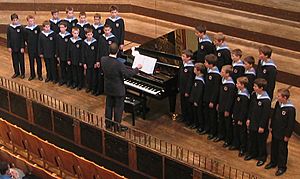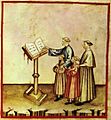Choir (music) facts for kids
A choir or choral group is a collection of people who sing together. They usually practice with a leader. Choirs often perform concerts or sing during religious services.
Some choirs are professional. This means the singers get paid for their work. Other choirs are semi-professional. Here, the leaders are paid, but the singers are not. Many choirs are amateur or recreational. In these groups, leaders might not be paid, and singers definitely are not. Some amateur choirs welcome anyone who wants to sing. Professional and semi-professional choirs, along with some amateur ones, usually require people to audition. They pick members based on how well they sing.
Contents
What Are the Parts of a Choir?
Singers in a choir are grouped by their voice types. Choral music is often written with different lines for each voice type. There are typically four main voice groups. They go from the highest sound to the lowest:
- Soprano (S): These are usually sung by adult females or children with higher voices.
- Alto (A): These are typically sung by adult females or children with lower voices. Sometimes, males who sing in a high, falsetto voice can also sing alto.
- Tenor (T): These parts are usually sung by adult males with higher voices.
- Bass (B): These are typically sung by adult males with lower voices.
Music written for choirs, called choral music, usually has at least two different vocal lines. These lines work together to create harmony. Even though there are four main voice ranges, composers often write more than four vocal lines. If a piece of music has more than four parts, the initials of the voice parts are repeated. For example, SSAATTBB means there are two soprano lines, two alto lines, two tenor lines, and two bass lines. Young children's choirs might be unison choirs, meaning everyone sings the same tune. Older children often sing in two (SS) or three (SSA) parts, or even more.
Different Kinds of Choirs
Choirs often organize themselves based on the types of voices they have. They also consider the age of the singers, the size of the group, or the kind of music they sing.
Here are the main voice categories:
- A mixed choir has both changed voices (usually adult males) and unchanged voices (usually adult females or children). The voices in this group are typically called SATB (soprano, alto, tenor, bass).
- An equal voice choir is made up of either changed voices (like a men's choir) or unchanged voices (like a women's or ladies' choir). These might be called a TB or TTBB choir for men, or an SA or SSAA choir for women.
- A youth choir can have many different voice combinations. This is because adolescence is when most male voices change from soprano or alto to tenor or bass. So, youth choirs might have SA, SAB, or SATB parts.
- A children’s choir is usually an equal voice group for singers who have not yet reached puberty. Some children's choirs also include older youth, so they might have changed voices (tenor and bass) too.
Choirs that organize themselves by size or the type of music they perform can be called:
- A chorus, choral society, or large ensemble is usually a choir with 40 or more singers. Many have over 100 people. These groups often sing big musical works, like operas or oratorios.
- A chamber choir will always have fewer than 40 singers. They are often much smaller.
- A small vocal ensemble or vocal group typically has 3 to 12 singers.
- An a cappella choir sings only music that has no pitched instruments playing along.
- There are also many choirs that focus on specific cultural or religious music traditions.
The Choir Part of a Church
The word choir can also mean a specific part of a church or cathedral. This is the area where the choir singers sit. The choir section is located between the nave (the main part of the church where people sit) and the sanctuary (where the altar is). The singers usually divide into two groups. They sit facing each other on either side of this area in "choir stalls." In cathedrals, the singers on the left (when facing the altar) are called “cantoris.” Those on the right are called “decani” (pronounced: dee-CAY-nye).
The Choir Part of an Organ
A large pipe organ can have three or more keyboards, called manuals. The third keyboard is often called the "choir" manual. Traditionally, the sound from the choir organ comes from pipes in a separate box. This box is usually behind the organist and faces the choir singers. It is often used to play along with the singers.
Originally, this was a separate instrument. The organist had to turn around to play it. Later, it became possible for the organist to play it from the main organ console.
Some Famous Choirs
Here are some well-known choirs:
- San Francisco Symphony Chorus
- Mormon Tabernacle Choir
- Huddersfield Choral Society
- BBC Symphony Chorus
- BBC Singers
- Red Army Choir
- National Youth Choir of Great Britain
- Vienna Boys’ Choir (German: Wiener Sängerknaben)
- Harlem Boys’ Choir
- Choir of St John’s College, Cambridge
- Choir of Kings’ College, Cambridge
- Westminster Cathedral Choir
Images for kids
-
Evensong rehearsal in the quire of York Minster, showing carved choirstalls
-
Egyptian Alexandria Jewish choir of Rabbin Moshe Cohen at Samuel Menashe synagogue, Alexandria, Egypt
-
Church singing, Tacuinum Sanitatis Casanatensis (14th century)
-
Luca della Robbia's Cantoria, Museo dell'Opera del Duomo, Florence
See also
 In Spanish: Coro para niños
In Spanish: Coro para niños











